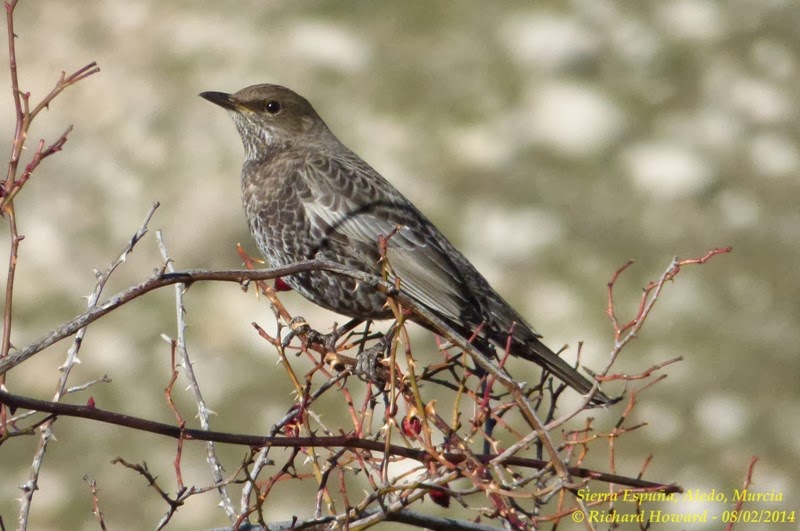Hi all,
Last Saturday (8th February) I decided it was high time to take a trip up to the nearest sierras to me, the Sierra Espuña. A mountainous area with pine forests on the lower slopes, and open meadow and rocky areas up on the top at a height of around 1500 metres. Apart from being very picturesque, my reason for going there was in the hope of seeing some of the northern thrushes, such as Redwing or Fieldfare. I had no luck with these, and didn’t even see Mistle or Songthrush, but the lack of these was made up for by seeing good numbers of Ring Ouzels.
Coming from Essex where you occasionally see one or maybe two on autumn passage, to see flocks of them flying around and calling to each other (and even one or two singing) is quite something. I would estimate that over the course of the morning I saw a minimum of 30 of them, with one flock flying overhead made up of 15 birds. These birds that come from Great Britain and presumably Scandinavia and the Alps, winter in numbers in the higher parts of Murcia (Espuña, Revolcadores) and around Nerpio (Albacete).
The zone where I see them are the ‘pozos de la nieve de Cartagena’, an open meadow area with many broken down buildings in the form of bee-hives. This is where, in years gone by, before refrigeration and when there was a lot more snow around, the snow would be shoveled into the wells and packed down, forming ice, which would then be cut out and transported by mules to Cartagena and Murcia. There are varios areas of ‘pozos de la nieve’, the most important being the 'pozos de la nieve de Cartagena' and 'pozos de la nieve de Murcia'. The Murcia ‘pozos’ are off in a different direction, and one of the ‘pozos’ there has been restored back into its original state for visitors to see.
'Sierra Espuña' as seen from the saladares del Guadalentín
View of the top of Espuña from the entrance
Sign explaining the Pozos
Ruin of one of the 'pozos'
View from the top of Espuña looking over neighbouring countryside
The 'Cartagena pozos' are in ruins, and seldom visited. There is also there is a well here which attracts the birds, especially in a dry winter such as we are having this year.
So, setting out from Los Belones at just after 8 a.m., I arrived at the entrance to the Espuña park at just after 9-30, and then spent the next half hour slowly climbing up on the narrow hairpin mountain roads. Parking the car, a further 20 minutes walk brought me to where I wanted to be. Conditions entering the park, clear skies, no wind and a pleasant 12ºC; conditions on the top still mainly clear skies with quite heavy grey clouds passing rapidly over, wind about force 4 south westerly and temperature I would guess at about 4ºC! Gloves needed!
I spent a couple of hours close to some wild rose bushes next to the well, which is where all the thirsty birds would come down and perch before dropping to the ground to have a drink. It was quite a spectacle. Apart from the Ring Ouzels, there were also Rock and Cirl Buntings, Crested and Coal Tits, Green, Gold and Chaffinches, and I also had an adult Golden Eagle fly over (although I saw it too late to get any decent photos).
View of the well area
Some of the birds seen:
Cirl Bunting
Coal Tit
Male Greenfinch
Goldfinch
Male Crossbill
Rock Bunting
Crested Tit
Male and female Crossbill
And a few photos of the commonest bird there, Ring Ouzel
One of the Short-toed Treecreepers seen
Crossing the motorway, I called into the ‘saladares del Guadalentín’, but here too was very quiet and cold, and the only birds of note were a group of 12 Magpies together and a single Dartford Warbler!
I didn’t stay there too long, so getting back to the Mar Menor earlier than I’d anticipated and it being still light (about an hour before sunset), I decided to have a look over the ‘marina de Carmolí’ for harriers going to roost. I spent an hour there seeing only four harriers, but it was well worth it – I saw three Marsh Harriers (including an adult male) and an adult female Pallid Harrier!
Record shot of the female adult Pallid Harrier
The following morning, I joined up with the volunteers of the ‘Asociación Calblanque’ who were clearing up the old salt storage area of the ‘Salinas de Rasall’ in Calblanque. As always there was a good number of Audouins Gulls there (I counted a minimum of 225), and in amongst them the adult Common Gull was once again present. Other birds seen in the open Salinas area were 10 Shelduck, Mallard, Little Egret, Common Sandpiper and Yellow-legged, Slender-billed and Black-headed Gulls.
Mixed in with the Audouin's Gulls, a single Common Gull
Part of the group of Audouin's Gulls
And that’s about all for now, so good birding!!
Ciauu
+copy.jpg)
+copy.jpg)
+copy.jpg)
+copy.jpg)
+copy.jpg)
+copy.jpg)























+copy.jpg)
+copy.jpg)
+copy.jpg)
No comments:
Post a Comment